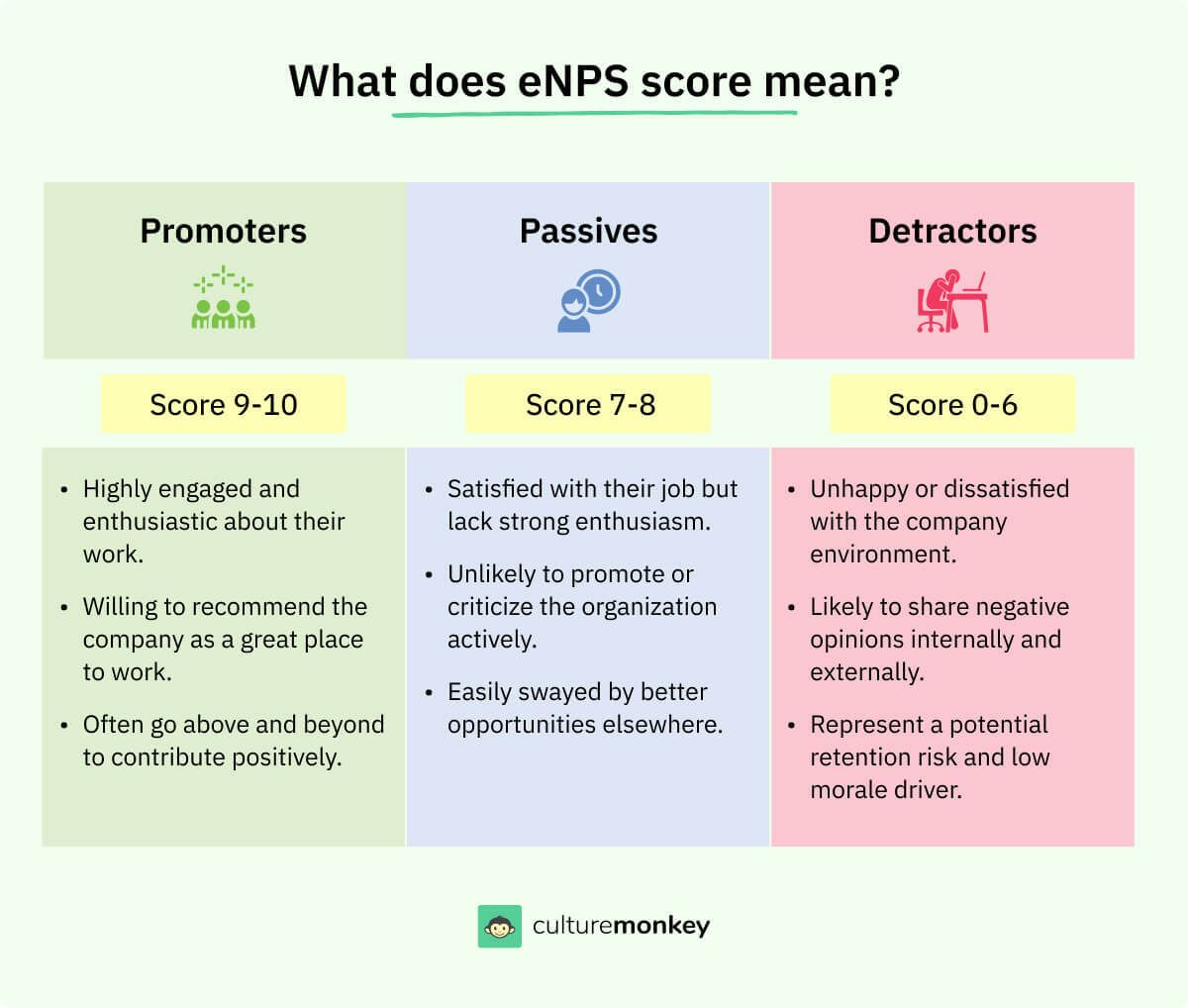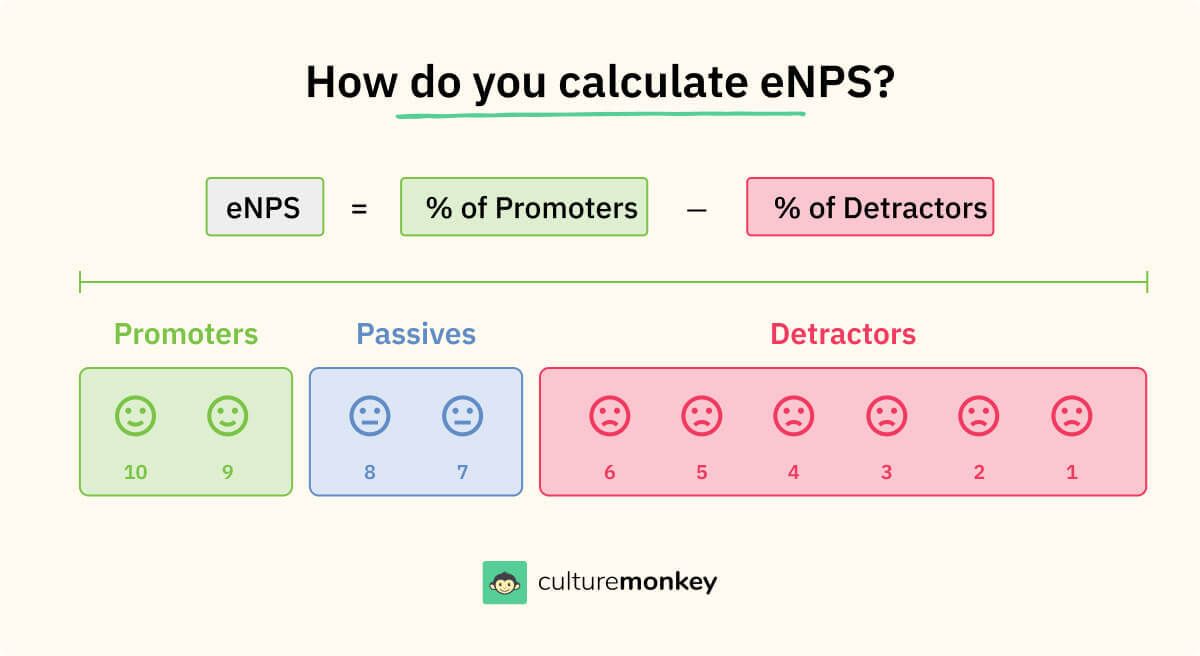What is eNPS (employee Net Promoter Score)?

A library might seem silent, but its shelves tell countless stories—some inspiring, others forgotten. When one book goes missing, you don’t notice right away. But if gaps keep appearing, patterns emerge: sections feel incomplete, the narrative weakens, and the entire collection loses its value.
That’s how workplaces are too—people’s voices and experiences are like those volumes. If you don’t track which “stories” are thriving and which are slipping away, you miss the bigger picture of your culture. eNPS works like your cataloging system—it highlights where the gaps are, which voices are strong advocates, and where attention is needed.
By reading those signals, leaders ensure the shelves stay full, connected, and valuable to everyone who walks in.
TL;DR
What is eNPS (employee Net Promoter Score)?
Pulse surveys are short, focused questionnaires designed to capture employee sentiment in real time. Unlike lengthy annual surveys, these quick check-ins act like a heartbeat monitor—providing leaders with timely insights into engagement, morale, and workplace challenges. Their brevity encourages higher participation, while their frequency ensures you never lose touch with how your teams are truly feeling.
What makes pulse surveys powerful is their agility. They allow organizations to identify emerging issues before they escalate, track the impact of new initiatives, and spot trends across different teams or locations.
Employees benefit too, as they feel heard more consistently, without the fatigue of long forms. By combining pulse survey data with other feedback tools, HR leaders can build a continuous listening culture.
The regular rhythm of these surveys doesn’t just highlight where people are thriving or struggling—it enables faster, more targeted action that keeps engagement strong. In today’s evolving workplace, pulse surveys are essential for staying connected and proactive.
What are the benefits of eNPS?

Employee Net Promoter Score (eNPS) gives leaders quick, actionable insights without overloading employees with long questionnaires. With consistent tracking, eNPS can shape strategy, reduce risks, and improve eNPS score. Here’s a closer look at the real benefits it offers:
TL;DR
eNPS gives leaders quick, cost-effective insights into employee loyalty and advocacy. It acts as an early warning system, predicting retention risks and highlighting areas that need attention.
Beyond engagement, strong eNPS scores connect directly to business outcomes—better customer experience, higher performance, and stronger morale. Done right, it’s more than a metric; it’s a growth driver.
- Acts as an early warning system: A drop in eNPS is often the first sign of disengagement. It alerts leaders before small frustrations snowball. This allows timely interventions to prevent costly turnover.
- Cost-effective to implement: eNPS surveys are short and easy to roll out. Unlike large-scale engagement programs, they require minimal budget. Even small companies can gather impactful insights quickly.
- Improves employee retention: eNPS highlights what makes people stay or leave. By acting on those insights, organizations reduce attrition. Lower turnover translates to less rehiring and training costs.
- Predicts business performance: Research links high eNPS to stronger business results. Engaged employees work harder, serve better, and innovate more. That momentum drives revenue, productivity, and customer outcomes.
- Enhances customer experience: Employees who are motivated naturally serve customers better. When teams feel valued, they create positive interactions. That directly boosts satisfaction, loyalty, and brand reputation.
- Boosts employee morale: Sharing feedback without fear empowers employees. When people feel heard, trust and motivation grow. That recognition cycle strengthens day-to-day morale across teams.
- Supports benchmarking efforts: eNPS can be compared across industries and regions. Leaders can see where they stand against peers. These benchmarks guide realistic improvement goals.
- Simple to understand and share: The scoring system is easy for everyone to grasp. Leaders, managers, and employees can interpret results quickly. That simplicity drives adoption across the organization.
- Drives continuous improvement: eNPS is designed for repeat measurement. Tracking over time shows whether changes are working. Leaders gain a clear view of progress and setbacks.
- Promotes employee engagement: By inviting regular input, eNPS builds trust. Employees know their voices shape culture and policy. This drives participation and long-term loyalty.
- Encourages employee development: Scores often reveal gaps in support or training. Leaders can invest in targeted development efforts. This improves skills and overall career growth.
- Strengthens employer brand: A strong eNPS signals a healthy culture. High scores become proof points in recruitment. That reputation attracts and retains top performers.
- Supports diversity and inclusion: eNPS data can highlight differences across groups. Leaders can identify gaps in inclusion efforts. This strengthens equity and belonging initiatives.
- Fuels workplace innovation: Engaged employees bring more ideas forward. A higher eNPS shows people feel safe contributing. This culture of creativity drives long-term competitiveness.
- Builds employee advocacy: Promoters become brand ambassadors inside and outside. They champion the workplace to peers and prospects. That advocacy strengthens reputation and recruitment pipelines.
- Encourages leadership accountability: Low scores often point to management issues. eNPS keeps leaders responsible for engagement outcomes. It ties leadership behavior directly to culture health.
- Provides actionable focus areas: Open-ended responses clarify the "why" behind scores. Leaders don’t just see numbers—they get context. This directs energy to the right problems.
- Facilitates real-time culture checks: Frequent surveys track fast-moving sentiment shifts. Leaders can adapt during times of change. That agility reduces blind spots in decision-making.
- Links directly to business KPIs: eNPS can connect to turnover, productivity, and profitability. Engagement insights stop being abstract. They become measurable drivers of organizational performance.
- Creates a feedback loop: Regular surveys and follow-up actions build trust. Employees see feedback turned into improvements. This loop sustains long-term engagement and loyalty.
Is eNPS the ultimate measure?
TL;DR
eNPS is powerful, but it’s not a standalone solution. It shows who your advocates and detractors are, yet misses context behind their scores.
For a complete view, eNPS should be combined with pulse surveys, lifecycle feedback, and cultural metrics. When integrated, it becomes part of a broader engagement strategy rather than the only measure.
Employee Net Promoter Score (eNPS) is a powerful tool for gauging employee loyalty and sentiment, but it cannot stand alone as the ultimate measure of engagement. It gives a clear snapshot of whether employees are likely to recommend the workplace, yet it doesn’t explain the full story behind their experiences, motivations, or challenges.
While eNPS highlights promoters, passives, and detractors, it misses critical factors like career growth, leadership trust, and workplace culture. To truly understand engagement, organizations need a combination of tools—pulse surveys, lifecycle surveys, retention analysis, and direct feedback sessions.
These methods provide context that a single score cannot capture. eNPS should therefore be treated as one component in a broader listening strategy. When integrated with qualitative feedback and other performance indicators, it delivers actionable insights. The takeaway: eNPS is highly valuable, but its strength lies in complementing other metrics to create a holistic and accurate picture of the employee experience.
NPS vs eNPS: How do they compare?

Net Promoter Score (NPS) and Employee Net Promoter Score (eNPS) are two metrics used to measure customer and employee loyalty, respectively. While they share some similarities, the two have some key differences.
Here are some of the main differences between NPS and eNPS:
| Aspect | NPS (Net Promoter Score) | eNPS (Employee Net Promoter Score) |
|---|---|---|
| Target Audience | Measures customer loyalty. | Measures employee loyalty. |
| Survey Questions | Asks customers how likely they are to recommend a company to a friend or colleague. | Asks employees how likely they are to recommend their employer as a place to work. |
| Scoring System | Ranges from -100 to +100; calculated by subtracting the percentage of detractors from the percentage of promoters. | Ranges from -100 to +100; calculated similarly but also considers passive respondents. |
| Frequency of Surveys | Typically conducted on a regular basis (e.g., quarterly or annually). | Conducted regularly but may be more frequent (e.g., monthly or bi-annually). |
| Purpose | Measures customer loyalty and identifies improvement areas. | Measures employee loyalty, identifies areas for improvement, and enhances employee engagement. |
What are the limitations of eNPS, and how to overcome them?

While eNPS (employee Net Promoter Score) is a valuable tool, it is not without its limitations. Here are some of the limitations of eNPS and how to overcome them.
Limited scope
One of the limitations of eNPS (employee Net Promoter Score) is its limited scope. eNPS only measures employee loyalty and engagement but does not provide insight into other aspects of employee experience, such as work environment, career growth opportunities, and job satisfaction.
Solution: To overcome this limitation, companies should consider using regular employee engagement surveys, including employee lifecycle surveys, pulse surveys, and more, that focus on these other aspects of employee experience. By combining multiple surveys, companies can gain a more comprehensive understanding of employee experience and identify areas for improvement.
Limited actionability
While eNPS (employee Net Promoter Score) can provide valuable insights into employee loyalty and engagement, it does not provide actionable recommendations for improvement.
Solution: To overcome this limitation, companies should ensure that eNPS surveys are designed to collect open-ended feedback from employees. This feedback can then be analyzed and used to identify specific areas for improvement.
Limited accuracy
The accuracy of employee net promoter scores can be affected by factors such as response bias, sample size, and timing of the survey. For example, if only a small percentage of employees respond to the survey, the results may not be representative of the entire employee population.
Solution: Companies should ensure that eNPS surveys are designed to minimize response bias and increase response rates. This can be achieved by ensuring that the survey is easy to understand and complete and incentivizing employees to participate.
Additionally, companies should ensure that eNPS (employee Net Promoter Score) surveys are conducted at regular intervals to ensure that the results are representative of the entire employee population.
Lack of contextual information
eNPS (employee Net Promoter Score) only provides a numerical score without any contextual information. This means that companies may be unable to identify the factors driving employee engagement or disengagement.
Solution: Companies should consider using eNPS surveys in conjunction with other surveys that provide more contextual information. For example, companies could conduct pulse surveys to gather additional feedback from employees on specific topics, such as work-life balance or leadership effectiveness.
Cultural differences
eNPS surveys may not be effective in all cultures or regions. Different cultures may have different expectations and perceptions of loyalty and engagement, which can impact the effectiveness of the survey.
Solution: To overcome this limitation, companies should consider adapting their eNPS surveys to be culturally sensitive and relevant. This can be achieved by working with local HR teams or consultants to ensure that the employee Net Promoter Score questions are appropriate and applicable to the specific cultural context.
What does eNPS score mean?

The score is calculated based on the responses of three categories of employees: Promoters, Passives, and Detractors.
Promoters
Promoters are employees who score 9 or 10 on the employee NPS survey question. These are highly engaged employees and loyal to the company, and are likely to recommend the company to others. They are a valuable asset to the company and can help to drive positive word-of-mouth marketing and referrals.
Passives
Passives are employees who score 7 or 8 on the eNPS survey question. These employees are neutral about the company and may be satisfied with their job but are not highly engaged or loyal. They are not likely to actively promote the company, but they are also not likely to speak negatively about it.
Detractors
Detractors are employees who score 0-6 on the eNPS survey question. These employees are unhappy or dissatisfied with the company, and may be actively disengaged or looking for other job opportunities. They can have a negative impact on the company's reputation and employee morale.
The resulting score can range from -100 to 100, providing companies with a quick and easy way to measure employee engagement and identify areas for improvement.
How do you calculate eNPS?

Calculating eNPS (employee Net Promoter Score) is a straightforward process that involves a simple survey. To calculate eNPS, companies typically ask employees to rate on a scale of 0-10 how likely they are to recommend their company as a place to work to friends or colleagues.
Based on the responses, employees are classified into three categories:
- Promoters (score 9-10): These are employees who are highly engaged and loyal to the company.
- Passives (score 7-8): These are employees who are neutral about the company.
- Detractors (score 0-6): These are employees who are unhappy or dissatisfied with the company.
To calculate the eNPS score, companies subtract the percentage of detractors from the percentage of promoters. The resulting score can range from -100 to 100, with higher scores indicating higher employee loyalty and engagement levels.
For example, if 40% of employees are promoters, 30% are passives, and 30% are detractors, the eNPS score would be 10 (40% - 30%). It's important to note that eNPS is a directional metric. Companies should use it as a starting point to identify areas for improvement and take action based on employee feedback.



Always treat your employees exactly as you want them to treat your best customers.
Global Practice Leader
FranklinCovey
eNPS benchmarks

Now that you have measured the eNPS scores, how do you know if the score you’ve got is good or bad?
eNPS (employee Net Promoter Score) benchmarks solves just that as they are useful for companies to measure and compare their employee engagement levels against industry standards. Here are some key pointers to keep in mind:
- eNPS scores vary by industry: Different industries may have different benchmarks for eNPS scores. For example, tech companies may have higher eNPS scores due to the nature of their work and company culture, while healthcare companies may have lower scores due to factors such as long working hours and high-stress levels.
- Regional differences: eNPS scores can also vary by region or country. For example, companies in the US may have higher eNPS scores than those in Europe or Asia due to cultural differences in the workplace.
- Use industry-specific benchmarks: It's important to use industry-specific benchmarks when comparing eNPS scores. This can help companies understand how they are performing relative to their peers and identify areas for improvement.
- Benchmark against competitors: Companies can also benchmark their eNPS scores against their competitors to better understand their market position and identify opportunities to differentiate themselves in terms of employee engagement.
- Company size matters: The size of a company can also impact eNPS benchmarks. Small companies may have higher eNPS scores due to closer relationships between employees and management, while larger companies may have more diverse employee populations and lower scores.
- Look at trends over time: eNPS scores can vary over time, so it's important to track trends and changes in scores by continuously listening to your employees leveraging employee survey templates. This can help companies identify areas where they have improved or declined and take action accordingly.
- Consider external factors: It's important to consider external factors that may impact eNPS scores, such as changes in the economy, company leadership, or industry trends. These factors may impact the benchmark for eNPS scores and should be taken into account when interpreting results.
- Employee demographics: The demographics of an organization's workforce can influence eNPS benchmarks. For instance, companies with a younger workforce might have different eNPS score expectations compared to those with a more diverse age range.
- Company life cycle: The stage of a company's lifecycle can affect eNPS scores. Startups and newly established firms may experience higher eNPS scores as they often have a sense of excitement and innovation. In contrast, more mature companies might have established routines and potentially lower scores.
- Industry disruptions: Rapid changes and disruptions within an industry can impact eNPS benchmarks. Organizations operating in industries facing significant disruptions may experience fluctuating scores as employees navigate uncertainties and changes.
- Remote work trends: With the rise of remote work, eNPS scores can be influenced by how well companies adapt to this shift. Organizations that effectively support remote work may see higher scores, while those struggling with the transition might face challenges in maintaining employee engagement levels.
Employee Net Promoter score by industry
The eNPS (Employee Net Promoter Score) offers valuable benchmarks for assessing employee loyalty and satisfaction within specific sectors. These scores vary widely, reflecting unique challenges, cultures, and expectations within each industry. Here’s a look at eNPS benchmarks across key sectors and what these scores mean for your organization.
eNPS benchmark for consulting industry
The consulting industry leads with an impressive score of 68, reflecting high levels of engagement driven by competitive benefits, growth opportunities, and team collaboration. This benchmark highlights the sector's strong emphasis on career progression and rewarding work culture. However, high performance expectations can create pressure, making continuous engagement initiatives essential.
eNPS benchmark for insurance industry
Insurance scores highest at 71, indicating a strong focus on employee engagement through comprehensive benefits, stability, and development programs. This industry often sees higher retention due to a focus on career paths and supportive policies. However, evolving regulations and workload can be sources of stress that companies must manage.
eNPS benchmark for technology & services industry
With a score of 61, technology & services sectors show a strong emphasis on innovation, flexibility, and professional growth, making it attractive for employees. The rapid pace of change demands regular engagement to keep teams motivated. Balancing innovation with stability remains a challenge to retaining top talent.
eNPS benchmark for e-commerce industry
Scoring 62, e-commerce reflects a blend of dynamic work environments and high adaptability. The sector offers flexibility and exciting growth opportunities, engaging its workforce effectively. The fast-paced nature of the industry can lead to burnout, emphasizing the need for robust employee support systems.
eNPS benchmark for retail industry
Retail’s score of 61 demonstrates efforts to enhance employee experiences through training, incentives, and supportive environments. Despite challenges like high turnover, retail organizations are finding ways to increase engagement. Listening to frontline feedback and offering development opportunities can further improve satisfaction.
eNPS benchmark for construction industry
With an eNPS of 45, construction has room for improvement but shows potential. Factors like safety concerns, project demands, and field conditions contribute to engagement variability. Companies prioritizing safety, training, and growth paths can significantly impact their workforce’s loyalty.
eNPS benchmark for logistics & transportation industry
Logistics & transportation scores 43, indicating challenges such as high operational demands and labor intensity. Employee engagement efforts focusing on safety, wellness, and recognition are crucial in this sector. Companies that support work-life balance and offer career progression see higher retention rates.
What are average Employee Net Promoter Scores?
The average Employee Net Promoter Score (eNPS) can differ widely based on industry, region, and a company’s internal culture. Understanding these averages offers valuable insights into how well your workforce is engaged compared to peers and global norms.
- Global average: Generally ranges from +10 to +20, reflecting moderately positive sentiment with clear opportunities for improvement.
- Regional differences: Scores shift by geography due to cultural norms, workplace practices, and labor laws across continents.
- Company size: Large organizations show broader score variation across departments, while smaller firms often see more consistency.
- Context matters: Average eNPS score by industry only serves as a starting point; industry-specific norms and historical data must guide interpretation.
- Tracking trends: Comparing scores over time helps leaders spot changes, act on insights, and strengthen employee experiences.
These averages and trends serve as a benchmark, offering a starting point for organizations to assess their own scores. However, it’s critical to contextualize these averages based on industry-specific norms and internal historical data to derive the most meaningful insights into employee engagement.
Regular comparisons with past performance and industry standards help to create positive experiences in the workplace for the employees.
How to structure your eNPS cycles?

Conducting eNPS surveys requires careful planning and structuring to generate useful insights. Here is the step-by-step process to help you structure your eNPS cycles effectively:
TL;DR
Running eNPS effectively requires clear structure—deciding when to survey, who to include, and how to follow up. Regular cadence ensures data is reliable and comparable.
Equally important is closing the loop. Sharing results, committing to actions, and tracking progress helps build trust. A well-structured cycle transforms raw feedback into measurable improvements.
- Set objectives and KPIs:
Decide what you want to learn (loyalty, change impact, manager effect).
Define success metrics (response rate, eNPS delta, time-to-action, participation by segment). - Choose audience and segmentation:
Select who gets surveyed (all employees vs. cohorts).
Plan cuts by function, location, tenure, manager, and employment type for meaningful comparisons. - Pick cadence and timing:
Set a predictable rhythm (quarterly or biannual; avoid peak workload or reorgs).
Lock survey windows (e.g., 7–10 days) and create an annual calendar. - Design the questionnaire:
Include the eNPS anchor question plus 1–3 targeted follow-ups for “why.”
Keep it under two minutes; avoid leading language and double-barreled items. - Guarantee anonymity and data governance:
Use minimum group sizes for reporting (e.g., n≥5).
Document data handling, retention, and access; communicate this clearly in pre-reads. - Prepare comms and channels:
Announce the purpose, time required, and privacy protections.
Deliver via email, Slack/Teams, or kiosk/QR for deskless staff; localize where needed. - Pilot and quality-assure:
Test with a small cross-section for clarity, device compatibility, and length.
Validate scoring logic, language, and routing before full launch. - Launch and drive participation:
Open the survey, send mid-window nudges, and close on schedule.
Track response rate by segment; enlist leaders to sponsor reminders without pressuring. - Analyze and prioritize:
Compute eNPS overall and by segment; flag statistically meaningful gaps.
Theme open-text, map drivers, and sort issues by impact × effort. - Close the loop and act:
Share topline results, what you heard, and 3–5 commitments with owners and dates.
Create manager playbooks, track actions in a shared dashboard, and celebrate quick wins. - Re-measure and iterate:
Run a light pulse on committed actions within 4–8 weeks.
Compare against baselines, adjust plans, and roll updates into the next cycle.
How to improve eNPS?

We know if you have come this far, you are indeed interested in measuring and improving your organizations' eNPS score. Although this is a tricky part, let’s see how you can manuever this and improve your eNPS scores -
- Act on employee feedback: Encourage your employees to provide feedback, then take action on the feedback they provide. Address issues and concerns that your employees bring up and communicate your action plan to your team.
- Improve employee engagement: Increase employee engagement by offering opportunities for career development, providing employee recognition for a job well done, and fostering a positive company culture.
- Enhance communication: Enhance communication between employees and managers, and promote transparency in the workplace. Clear communication helps to build trust and strengthens relationships between team members.
- Encourage teamwork: Create an environment that fosters teamwork, collaboration, and open communication. Encourage your employees to work together on projects and build a sense of camaraderie.
- Increase employee recognition: Recognize and reward your employees for their hard work and achievements. It can be as simple as a thank-you email or as elaborate as an employee appreciation event.
- Provide opportunities for learning and development: Offer training and development programs that help your employees to grow their skills and knowledge. Providing opportunities for professional growth can increase employee engagement and satisfaction.
- Address work-life balance: Addressing work-life balance concerns and providing support to employees who are struggling to balance their work and personal life will encourage them to take breaks and provide flexible scheduling options when possible.
- Focus on employee wellness: Prioritize employee wellness by providing wellness programs, promoting healthy habits, and providing mental health support. Employees who feel cared for and supported are more likely to be engaged and loyal to their company.
Implementing these strategies can create a positive work environment and improve your eNPS score. Remember, a high eNPS score is an indication of employee satisfaction and loyalty, which translates to better business and employee performance.
5 Follow-up questions you need on your eNPS survey
Following up on your eNPS survey results is crucial for obtaining deeper insights into employee sentiments. By asking the right questions for your follow up survey, you can uncover specific drivers behind employee satisfaction, areas that need attention, and actionable opportunities for improvement. Here are five essential follow-up questions to include in your eNPS survey:
1. What was the primary reason for the score you gave?
This open-ended question helps pinpoint the main factors influencing an employee’s rating. It provides context to their score and highlights what they value most or what may be causing dissatisfaction.
2. What changes would make this organization a better place to work?
Employees often have unique perspectives on what could enhance their work environment. This question invites constructive feedback on areas like company culture, leadership, or operational improvements
3. What is one thing that keeps you motivated to work here?
Understanding what keeps employees engaged can offer valuable insights into your organization’s strengths. It also helps to identify which aspects of your culture or benefits resonate most with your workforce.
4. If you could change one thing about your work experience here, what would it be?
This question encourages employees to prioritize their feedback and reveal their top concern, providing actionable data to HR and leadership teams.
5. Would anything hold you back from referring friends or colleagues to work here?
Referral hesitations can reveal underlying issues that might not surface in general feedback. Knowing what would prevent employees from promoting your workplace can guide initiatives to strengthen culture and trust.
Why ask an employee Net Promoter Score question?

Ever wondered why you should bother asking your employees the infamous Employee Net Promoter Score (eNPS) question? Well, that's a question worth exploring.
- Unearth hidden insights: The eNPS question goes beyond simple satisfaction, uncovering whether employees are true advocates or quietly disengaged.
- Identify areas for improvement: Responses highlight critical focus points like culture, leadership, or work-life balance that need immediate attention.
- Track progress over time: Regular eNPS results act as checkpoints, showing whether engagement strategies are driving measurable improvement.
- Measure employee loyalty: Promoters represent your most loyal employees, who are more likely to stay, perform, and refer new talent.
- Make informed decisions: eNPS data equips leaders with evidence-based insights for shaping policies and engagement strategies.
- Strengthen employer branding: A strong eNPS reflects a positive workplace reputation, which helps attract and retain top talent.
- Encourage continuous listening: Asking the question consistently builds trust by showing employees their opinions are valued.
- Link to business performance: Higher eNPS scores correlate with lower turnover, stronger productivity, and improved customer satisfaction.
How to use eNPS effectively?
Ah, the elusive art of using eNPS (Employee Net Promoter Score) effectively – it's like having a powerful tool in your hands, but knowing how to wield it is the real game-changer. Here's your roadmap to eNPS success.
- Ask the right questions: Start by crafting thoughtful, open-ended follow-up questions to your eNPS survey. Don't settle for just the numerical score. Dive deeper. Ask employees why they gave that score. Their comments can be gold mines of insights.
- Consistency is key: Make eNPS a regular practice, not just a one-time affair. Regular surveys, whether quarterly or annually, allow you to track employee engagement trends and measure progress over time.
- Analyze, don't just collect: Don't let those survey results gather digital dust. Analyze the data diligently. Look for patterns, trends, and common sentiments. This is where you unearth the gems that can drive positive change.
- Share and discuss: Transparency is your friend. Share the results with your team and discuss them openly. This fosters a culture of improvement and shows employees that their voices matter.
- Take action: The most crucial step! Use the feedback to make tangible improvements. Address pain points, celebrate successes, and communicate the changes made based on the feedback. Actions speak louder than surveys.
- Continuous feedback loop: Keep the conversation going. Regularly update employees on the progress made and ask for their input on ongoing initiatives. It's about building a culture of constant improvement.
- Don't forget to celebrate: When improvements lead to positive changes in eNPS scores, celebrate them. Recognition reinforces the idea that feedback leads to progress.
How eNPS fits into your broader employee experience strategy
eNPS is valuable, but it’s just one piece of a larger employee experience puzzle. To get real impact, organizations must embed it alongside other initiatives, ensuring that insights connect with every stage of the employee journey. Here’s how eNPS fits into a holistic strategy:
- Connects with lifecycle surveys: Pair eNPS with onboarding, exit, and growth-stage surveys to capture sentiment at every career milestone.
- Informs leadership coaching: Use feedback patterns to shape leadership development, ensuring managers build trust and improve team culture.
- Aligns with performance data: Combine eNPS with productivity, retention, and absenteeism metrics to see the link between sentiment and outcomes.
- Guides recognition programs: Identify promoters and leverage insights to design reward systems that celebrate advocacy and loyalty.
- Supports change management: Track eNPS before, during, and after major transitions to measure how employees adapt and respond.
- Feeds into D&I initiatives: Segment scores by demographic groups to reveal disparities and guide inclusion-focused actions.
- Strengthens communication loops: Pair eNPS findings with town halls, manager one-on-ones, and focus groups to keep dialogue transparent.
5 Common mistakes companies make when using eNPS
While eNPS is simple to administer, many organizations fall into traps that undermine its effectiveness. Missteps often lead to skewed results, poor employee trust, or wasted opportunities to act on valuable insights. Avoiding these 5 mistakes is essential to ensure the metric serves as a reliable guide to engagement and culture.
TL;DR
Organizations often misuse eNPS by celebrating scores without context, running surveys inconsistently, or ignoring feedback afterward. These mistakes make results unreliable.
Overloading surveys or skipping segmentation also weakens insights. Avoiding these pitfalls ensures eNPS remains a precise tool that drives action, not a vanity metric. Proper use builds credibility and trust.
- Treating eNPS as a vanity score: Some leaders celebrate high numbers without digging deeper into what drives them. This reduces eNPS to a bragging point rather than a meaningful tool for improvement.
- Failing to close the feedback loop: Collecting survey responses but not acting on them leaves employees disillusioned. It signals that feedback isn’t valued, damaging trust and participation.
- Surveying at inconsistent intervals: Running surveys irregularly makes it impossible to track meaningful trends. Without a consistent rhythm, data loses context and becomes unreliable.
- Ignoring demographic or team segmentation: Looking only at overall scores hides crucial insights within subgroups. This prevents leaders from addressing issues specific to certain teams or demographics.
- Overloading surveys with extra questions: Adding too many questions undermines the simplicity of eNPS. It frustrates employees, lowers completion rates, and compromises the clarity of the results.
Things to keep in mind about employee net promoter score

Here are some key things to keep in mind about employee Net Promoter Score (eNPS):
- Confidentiality: Employee feedback is personal and confidential, and it is important to communicate this to employees. Ensure that the feedback is collected anonymously to build trust and encourage honesty.
- Timing: The timing of the eNPS survey is crucial to its success. The survey should be conducted at a time when employees are most engaged and motivated. Conducting the survey during a busy period may result in low participation and inaccurate feedback.
- Continuous improvement: eNPS is an ongoing employee engagement monitoring and should be used as a continuous feedback loop to improve workplace engagement and employee experience over time. Continuously monitor progress and make improvements as needed.
- eNPS is not a one-time event: eNPS surveys must be conducted regularly to track employee satisfaction and engagement over time. Establishing a regular cadence for employee surveys and communicating to employees when they can expect to receive them is important.
- eNPS is only one tool for measuring engagement: While eNPS can be valuable for assessing employee engagement, it's not the only tool available. It's important to consider other metrics, such as employee satisfaction surveys, turnover rates, and absenteeism, to get a complete picture of employee engagement.
- eNPS is most effective when coupled with action: Simply measuring eNPS scores won't do much to improve engagement unless action is taken based on the results. Employers should be prepared to analyze the results, identify areas for improvement, and take concrete steps to address any issues that are identified.
- eNPS varies: eNPS scores can vary based on the industry and the specific company culture. It's important to understand what a "good" eNPS score means for your organization and how it compares to others in your industry. Benchmarks can be helpful, but they should be viewed as guidelines rather than strict rules.
- Not the only source: eNPS should not be the sole measure of employee engagement or satisfaction. It is just one tool among many that can help organizations understand their workforce. It's important to use eNPS in conjunction with other measures, such as employee satisfaction surveys, mental health surveys, manager effectiveness surveys, employee lifecycle surveys.
How to integrate eNPS with other employee feedback systems
Integrating eNPS (Employee Net Promoter Score) with other employee feedback systems can provide a more holistic view of employee engagement and satisfaction. While eNPS offers a quick snapshot of loyalty and sentiment, combining it with other tools can enhance its impact. Here’s how to make it work effectively:
- Combine eNPS with pulse surveys: Supplement your periodic eNPS scores with shorter, frequent pulse surveys. This allows for a continuous check-in on specific issues, providing context to eNPS trends and enabling quicker responses to employee concerns.
- Link with employee lifecycle surveys: Integrating eNPS with surveys conducted at key stages of the employee lifecycle—such as onboarding, exit, and performance milestones—can reveal how engagement evolves over time. This gives valuable insights into areas needing attention at different career stages.
- Qualitative feedback channels: Use open-ended questions, focus groups, and one-on-one meetings alongside eNPS to gather qualitative data. This helps uncover the “why” behind scores, offering deeper, actionable insights.
- Incorporate manager feedback mechanisms: Managers play a key role in engagement. Integrate eNPS results with feedback collected from manager effectiveness surveys to align leadership development efforts with engagement goals.
- Data-driven dashboards: Create centralized dashboards that combine eNPS data with other key engagement metrics like retention rates, productivity, and employee satisfaction scores. This makes it easier to track trends, correlations, and measure the impact of initiatives over time.
- Tie feedback to action plans: Use the combined insights from eNPS and other feedback systems to build targeted action plans, ensuring employees see tangible improvements based on their input. This helps foster a culture of trust and continuous improvement.
How do you use eNPS ft. CultureMonkey, to enhance your employee experience through eNPS
eNPS software is most effective when it’s continuous, structured, and supported by the right tools. CultureMonkey helps HR leaders go beyond the score by simplifying survey design, improving participation, and converting feedback into actionable strategies. Here’s how CultureMonkey enhances your eNPS cycles:
- Smart survey fatigue prevention: Use short, science-backed pulses with no-login access to increase response rates without overwhelming employees.
- Seamless HRMS integrations: Connect easily with platforms like Darwinbox and Zoho People for smooth survey launches and real-time insights.
- Workplace integrations: Collect feedback directly through Slack, Teams, and WhatsApp, making surveys accessible where employees already engage.
- Text intelligence & AI-driven insights: Analyze open-ended feedback for themes, sentiment, and receive actionable recommendations for improvement.
- Dual-layer dashboards: Give managers micro-level heat maps while leadership sees high-level trends, benchmarks, and readiness signals.
- Mobile-friendly & multilingual surveys: Reach a global workforce with inclusive, easy-to-use surveys across devices and languages.
- Enterprise-grade security: Ensure employee trust with GDPR compliance, encryption, and role-based data access.
- Scale-ready infrastructure: Handle growing headcount and global expansion without performance issues or data silos.
Summary
Conclusion
Employee Net Promoter Score (eNPS) is one of the most practical ways to understand how your workforce feels about the organization. By asking a simple yet powerful question, leaders can identify who their true advocates are, where engagement is slipping, and what changes will make the biggest difference.
On its own, eNPS won’t solve every challenge, but when combined with continuous listening, thoughtful follow-ups, and clear action plans, it becomes a catalyst for retention, culture, and performance. The key is consistency—tracking scores regularly, acting transparently on feedback, and building trust over time.
For organizations looking to make eNPS cycles effortless, CultureMonkey provides the tools to design surveys, analyze feedback, and turn insights into action. With its integrations, dashboards, and AI-driven recommendations, it helps HR teams enhance engagement while keeping employees truly heard.
FAQs
1. What is employee Net Promoter Score (eNPS)?
Employee Net Promoter Score (eNPS) is a metric used to measure employee satisfaction and loyalty within an organization. It is based on a single question: "On a scale of 0 to 10, how likely are you to recommend this company as a great workplace?" Employees are categorized as Promoters (score 9-10), Passives (score 7-8), or Detractors (score 0-6).
2. How to calculate eNPS for my organization?
To calculate eNPS, first, survey your employees using the eNPS question. Then, determine the percentage of Promoters and Detractors among the respondents. Finally, subtract the percentage of Detractors from the percentage of Promoters. The resulting score can range from -100 to 100, with higher scores indicating a more positive employee sentiment.
3. Why is eNPS important for employee engagement?
Employee Net Promoter Score (eNPS) is crucial for employee engagement because it serves as a key indicator of how connected and satisfied employees are with their organization. Engaged employees tend to be Promoters, those who give high eNPS scores, indicating they would recommend their workplace. Tracking eNPS provides HR insights into the effectiveness of their engagement efforts.
4. What are the benefits of using eNPS in HR?
The use of eNPS in HR comes with numerous advantages. It offers real-time feedback, helping HR teams stay attuned to employee sentiment. By identifying Promoters and Detractors, organizations can develop targeted strategies to enhance workplace satisfaction and loyalty. eNPS also aids in tracking changes over time, allowing HR to measure the impact of their initiatives.
5. Can eNPS help reduce employee turnover?
Yes, eNPS can play a significant role in reducing employee turnover. When employees are engaged, satisfied, and classified as Promoters in eNPS surveys, they are more likely to remain with the organization. High eNPS scores often indicate a positive workplace culture, where employees feel valued and connected to their jobs. This sense of loyalty and contentment translates into increased employee retention.
6. What are some best practices for implementing eNPS surveys?
Best practices for implementing eNPS surveys include keeping the survey short and simple, ensuring anonymity, conducting surveys regularly, analyzing and acting on the feedback, and involving employees in the process to improve response rates and engagement.
7. Are there any alternatives to eNPS for measuring employee satisfaction?
Yes, there are alternatives to eNPS, such as employee satisfaction surveys, employee engagement surveys, and pulse surveys. These methods often include a broader range of questions and provide more comprehensive insights into employee satisfaction and engagement. Organizations may choose the method that best aligns with their specific goals and needs.
8. What is a good eNPS score to aim for?
A good eNPS score generally falls above +30, which indicates strong employee loyalty and satisfaction. Scores above +50 are considered excellent, showing most employees are promoters. Anything below zero signals more detractors than promoters and requires immediate attention. While benchmarks vary by industry, consistently improving your own score matters more than hitting a universal target.
9. How often should I run an eNPS survey?
Most organizations run eNPS surveys quarterly or biannually to balance consistency with avoiding survey fatigue. Too infrequent, and you lose timely insights; too frequent, and employees may disengage. The right cadence depends on company size, industry, and change pace. Aim for a predictable rhythm that captures trends while giving teams enough time to act.
10. Should I use eNPS alone or with other surveys?
Net Promoter Score employee engagement should never be used in isolation, as it only measures loyalty through one question. Pairing it with pulse surveys, lifecycle surveys, and open-text feedback gives deeper context and reveals root causes behind scores. This combination ensures you capture both quantitative trends and qualitative insights, creating a more holistic understanding of employee engagement and culture.




